Optical Soliton Structure Solutions, Sensitivity, and Modulation Stability Analysis in the Chiral Nonlinear Schrödinger Equation With Bohm Potential
Abstract
This study examines the optical soliton structure solutions, sensitivity, and modulation stability analysis of the chiral nonlinear Schrödinger equation (NLSE) with Bohm potential, a basic model in nonlinear optics and quantum mechanics. The equation represents wave group dynamics in numerous physical systems, involving quantum Hall and nonlinear optical structures. To attain exact solutions, we utilize the generalized exponential rational function (GERF) method and the Paul-Painlevé (PP) approach, revealing a various set of optical soliton solutions, containing exponential, hyperbolic, and trigonometric function-based solitons. By utilizing suitable parametric values, we provide 3D, 2D, and contour visualizations to demonstrate the soliton characteristics. Moreover, a comprehensive sensitivity and modulation stability analysis is carried out, presenting the impact of parametric alteration on soliton behavior. The findings exhibit the emergence of dark, bright, and periodic soliton solutions, which play a key role in understanding nonlinear wave propagation in topological and optical systems. The novelty of this work lies in enhancing the study of chiral soliton within the Bohm potential framework, yielding new observations into their stability, modulation, and structural properties.
1. Introduction
Nonlinear partial differential equations (NLPDEs) are fundamental in modeling a wide range of physical phenomena and dynamic processes. The study of NLPDEs is essential due to their widespread applications in distinct fields such as fluid dynamics, optics, control theory, quantum mechanics, and plasma physics [1–12]. One of the most key challenges in nonlinear physics is attaining analytical solutions for NPDEs, particularly solitary wave solutions, which deliver valuable insights into nonlinear wave propagation phenomena. Solitary waves, or solitons, are unique in that they kept their amplitude, shape, and speed while traveling through a medium, unlike most waves, which disperse and lose energy over time. The persistence of soliton waves has led to their application in fields such as optical communication, plasma wave propagation, and water waves. Moreover, fractional-order derivatives, a key feature in nonlinear fractional differential equations (NFDEs), have become increasingly important in scientific research. The incorporation of fractional derivatives introduces complexity to these equations, adding a layer of nonlinearity that makes the analysis of solitary waves in NFDEs particularly challenging yet valuable for understanding complex dynamic systems [13–24].
Recently, distinct efficient methods have been utilized to attain soliton solutions for NLPDEs. The modified expansion rational function method (MERFM) has been utilized to acquire diverse soliton solutions for the unstable nonlinear Schrödinger equation (NLSE), exhibiting its applicability to nonlinear physical models [25]. Additionally, the MRE method delivered bright-dark soliton and kink solutions for the (2 + 1)-dimensional elliptic NLSE, which is suitable for optical pulse propagation [26]. The -expansion method derived soliton solutions for the (3 + 1)-dimensional Zakharov–Kuznetsov model, with applications in plasma physics [27]. The GREM method created novel analytical solutions for the Gardner–Kadomtsev–Petviashvili equation, enabling the study of shallow-water waves [27]. The three-wave, positive-quadratic, and double-exponential techniques were employed to produce soliton solutions for the unstable NLSE, verified through modulational instability analysis [28]. The dynamic wave behaviors of the M-fractional nonlinear Gross–Pitaevskii equation have been analyzed by utilizing advanced analytical methods in [29]. The soliton neuron model is investigated to analyze the propagation of action potentials through soliton solutions, applying multiple integration approaches [30]. The fractional telegraph equation is studied for its solitary wave dynamics and chaotic behavior by utilizing novel analytical methods and graphical sensitivity analysis [31]. The (2 + 1)-dimensional graphene sheet equation is analyzed for its thermal wave transmission behavior, by using the Hirota bilinear method to derive multiple soliton solutions [32]. Additionally, nonlinear wave dynamics in a magneto-electro-elastic circular rod are studied by utilizing fractional soliton solutions and chaotic sensitivity analysis [33]. Finally, the (3 + 1)-dimensional Kadomtsev–Petviashvili equation is examined for its hybrid wave structures, employing the Hirota bilinear method and long-wave technique [34].
Nonlinear PDEs prescribe most physical events and dynamic techniques. The past decade has yet to see a reduction in the search for new ways to solve problems and different types of solitary wave solutions. Many theoretical components for developing alternative procedures can be found in the literature as: authors have implemented the functional variable approach to solve the 2-dimensional Maccari system and the (3 + 1)-dimensional fractional modified KdV-ZK equation [35]. Zafar et al. [36] have investigated and analyzed the optical solitons of the complicated Ginzburg–Landau equation by utilizing the Kudryashov method. Discover new kinds of one-soliton and two-soliton solutions to the Burgers equation by using the Darboux transformation through the Lax pair [37]. Investigating soliton solutions by using the simplest sine-cosine method for an inherent fractional discrete nonlinear electrical communication network in [38]. The NLSE with group velocity dispersion, which describes the motion of optical solitons in nonlinear media, is solved by using the modified extended direct algebraic approach for acquiring optical solitons [39]. The fractional simplified Camassa–Holm equation’s closed-form wave solutions have been investigated using possible methods, namely the sine-Gordon expansion method [40, 41]. Tianle et al. found straightforward, broad, and efficient solutions by using the modified Hirota bilinear technique [42, 43]. The double integral approach is accurate and suitable for use in metal solidification applications [44]. For the model under consideration, four types of nonlinearity are found that produce bright, dark, and singular solitons solutions [45]. Investigation of the complex Ginzburg–Landau problem that arises in nonlinear optics analytically by using -expansion approach [46]. Using the two-variable -expansion method and the modified Riemann–Liouville fractional derivative, this work tries to find exact solutions for fractional dispersive longwave (DLW) equation and approximate long water wave (ALW) equation [47–49]. Dark and rational solitons have been obtained by using the unified technique and the local M-derivative qualities [50].
While this study provides significant contributions to the optical soliton structure of the CNSE with Bohm potential, it has specific limitations. The examination is restricted to distinct parameter choices, as the exact soliton solutions attained by utilizing the generalized exponential rational function (GERF) method and the Paul-Painlevé (PP) approach may not fully generalize to all nonlinear optical and quantum systems. Additionally, the analysis remains purely theoretical, lacking experimental validation, which is crucial for validating the real-world applicability of the findings. The model also considers a two-dimensional framework, whereas higher-dimensional effects, which play a key role in practical systems, are not studied. Furthermore, external perturbations such as loss, dispersion variations, and nonlinear gain are not included. While sensitivity and modulation stability analyses are executed, a more extensive numerical stability analysis, such as linear stability analysis or direct numerical simulations, would deliver deeper observation. However, this work lays a theoretical foundation for understanding chiral solitons in nonlinear optical and quantum systems, representing a basis for future experimental and computational studies.
The novelty of the present study lies in tackling a critical research gap in the analysis of the chiral NLSE with Bohm potential (CNLSE-BP). While Rizvi et al. [51] examined chirped soliton solutions by utilizing the Jacobian elliptic function method, their solutions exhibited singularities, limiting their practical applicability. In contrast, our study utilizes the GERF method and the PP approach, yielding singularity-free soliton solutions and demonstrating a distinct set of optical solitons, including dark, bright, and periodic structures. Moreover, we conduct a comprehensive sensitivity and modulation stability analysis, delivering new insights into soliton behavior under parametric variations. These contributions advance the understanding of chiral solitons within the Bohm potential framework, enhancing their applicability in quantum mechanics and nonlinear optics.
The remaining part of the manuscript is divided into different sections. A successful and effective GERF method for obtaining analytical solitary wave solutions to the CNLSE-BP, along with its steps, are briefly described in Section 2. The types of analytical wave solutions, such as trigonometric, hyperbolic, exponential function, rational form, and so on, are covered in Section 3. In Section 4, we provide a summary of PPA. We use the PPA to obtain an exact soliton shape in Section 5. In Section 6, accurate soliton solutions are physically presented using Mathematica 11 software, sensitivity and modulation stability analysis are analyzed in the purposed model. Section 7 contains the conclusion of this article.
2. The Summary of GERF Method
The particular method for solving NLPDEs is the GERF method [19]. The important steps are specified as:
Step 1
Step 2
Step 3
To determine the value of N by utilizing the homogeneous balance method in Equation (4).
Step 4
The system of algebraic equations is obtained by substituting Equation (4) into Equation (3) using Equation (5). We used Mathematica software to get the solution for this system, and then we used Equation (2) to insert the solution we acquired for Equation (5) into Equation (4). At last, the solution for Equation (1) has been acquired.
The reliable soliton solutions of NLPDEs are investigated using the GERF technique, which produced helpful, more general, and exact wave solutions of NLPDEs. In short, the GERF approach may be utilized for organizing the wave velocity and is powerful, prevailing, and more broadly applicable to investigate various exact traveling wave solutions for NLPDEs.
3. Mathematical Analysis
4. Summary of PP Approach
The PP technique is mostly used to solve nonintegrable nonlinear PDEs. The following are the key steps:
Step 1
Step 2
Step 3
Step 4
In this step, we find the values of K,N, and Bi where i = 1, 2 … n by using Equation (62) in Equation (61) and comparing the coefficient of different exponent of H(y)e−Nξ.
5. Implementation of PP Approach on CNLSE-BP
Uξ = B1KH(Y)2e−2Nξ − B1H(Y)Ne−Nξ.
Uξξ = 2B1K2H(Y)3e−3Nξ − 3B1KH(Y)2Ne−2Nξ + B1H(Y)N2e−Nξ.
6. Results and Discussion
- •
Figures 1 and 2 yield a comprehensive visualization of the real and imaginary parts of the attained soliton solution with parametric values c = 1.01, γ = 1.01, η = 1.03, κ = 1.06, m0 = 0.07, ς = 0.05. The 3D plots show the high degree of localization and stability of the soliton, with both components revealing well-defined peaks that keep their form across the propagation domain. The 2D plots further verify that the amplitude remains stable over time, representing minimal dispersion effects. The contour plots show clear and sharp boundaries, showcasing the soliton’s robust structure. Dynamically, the soliton solutions illustrate typical characteristics of stable dark solitons maintaining their amplitude and shape during propagation. The parametric changes investigated in the 2D plots present that while the soliton’s amplitude is sensitive to certain parameter changes the overall structure remains unchanged. This represents that the soliton solutions possess good stability against small perturbations, which is important for real-world applications in nonlinear optics and chiral media systems.
- •
Figures 3 and 4 show periodic soliton solutions exhibiting stable, cyclic behavior across the space-time domain with parametric values c = 1.1, γ = 1.1, η = 1.3, κ = 1.6, m0 = 0.07, ς = 0.5. Both 3D and contour plots show that the solutions keep their wave patterns without distortion, revealing a robust dynamical balance between nonlinearity and dispersion impact. The 2D plots further clarify the spatial sensitivity of amplitude but confirm that periodicity is kept over time. Dynamically, these periodic solitons show characteristics essential for applications needing stable wave propagation, such as in optical fiber systems, photonic crystals, and chiral materials.
- •
Figures 5 and 6 depict the real and imaginary parts of the attained soliton solution of Equation (50) for distinct parameter values c = 1.1, γ = 2.1, η = 2.03, κ = 1.08, m0 = 1.07, ς = 0.05. The 3D plots in Figures 5 and 6 show the localized nature of the solution, where the wave peaks are well-defined and keep their structure during propagation in the space-time domain. The real and the imaginary parts of Figures 5 and 6 show smooth, stable waveforms without significant dispersion, which are typical characteristics of bright soliton solutions. The 2D plots further depict this behavior by representing periodic oscillations of the solution’s amplitude for different spatial values (x = 1.0, 1.5, 2.0). The oscillations remain bounded and stable, showing that the soliton maintains its shape over time. Moreover, the contour plots deliver a clear top-down view of the propagation dynamics, where consistent wave structures and sharp gradients are examined, reinforcing the localized and nondispersive nature of the soliton. This behavior is essential for applications in nonlinear optical systems and chiral media, where keeping energy localization and minimizing dispersion are critical for effective signal transmission and wave control.
-
Figures 7 and 8 display the real and imaginary parts of the solution to Equation (58) under specific parameter values: c = 1.3, γ = 2.1, η = 4.3, κ = 0.6, m0 = 4.7. Figures 7 and 8 show the solution’s features through 3D plots, 2D projections, and contour plots. The 3D plots demonstrate the wave-like behavior of the solution, presenting periodic oscillations over time. The 2D plots, which show the solution as a function of t for distinct values of x, further verify its periodic nature by revealing sinusoidal-like patterns. The contour plots deliver an alternative perspective, clarifying the propagation of wavefronts in the x–t plane, which also shows periodicity.
- •
Figures 9 and 10 represent the real and imaginary components of the solution to Equation (67) for the given parameter values: c = 1.3, γ = 2.1, η = 1.3, κ = 0.6, m0 = 4.7, C0 = 1, K = 1, A = 2, N = 0.02. Figures 9 and 10 provide diverse visual representations, including 3D plots, 2D projections, and contour plots. The 3D plots in Figures 9 and 10 clarify an oscillatory nature of the solution in both space and time. The 2D plots present periodic waveforms that fluctuate over time for different values of x, further confirming a periodic behavior. The contour plots illustrate wavefront propagation in the x–t plane with a structured, repeating pattern, reinforcing the periodic nature of the solution.
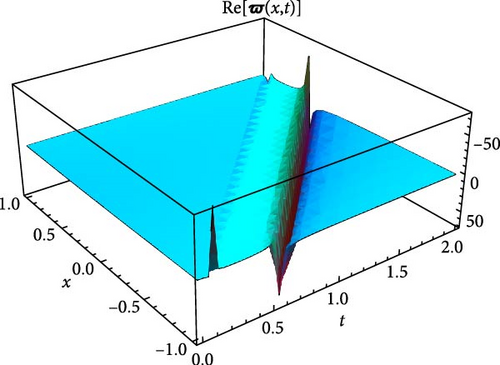
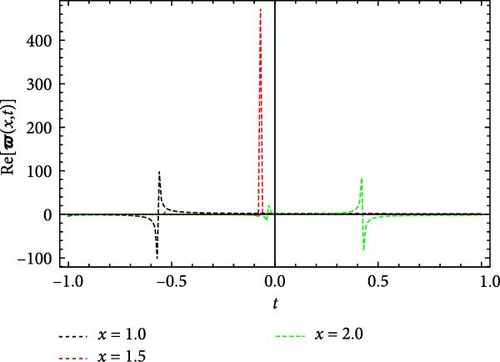
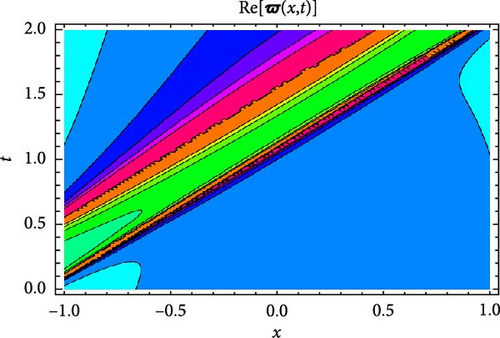
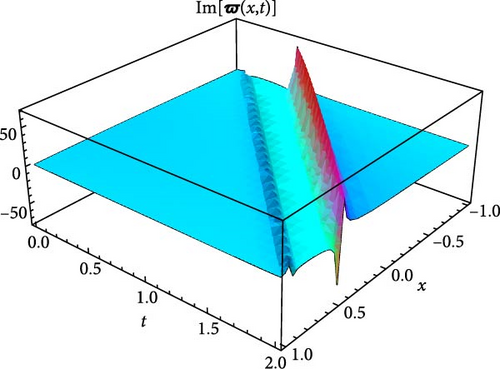
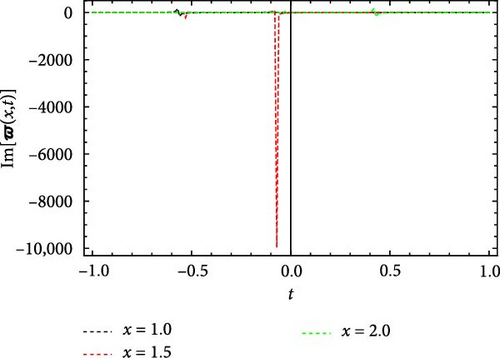
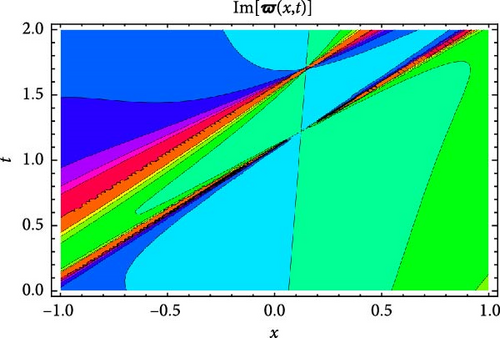
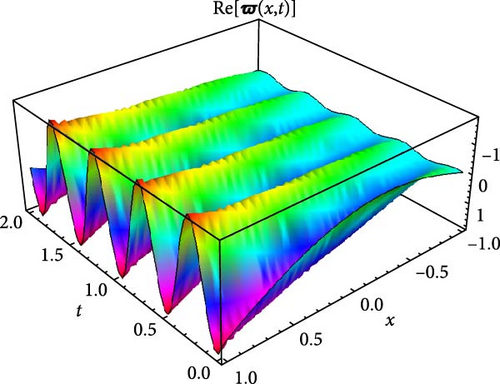
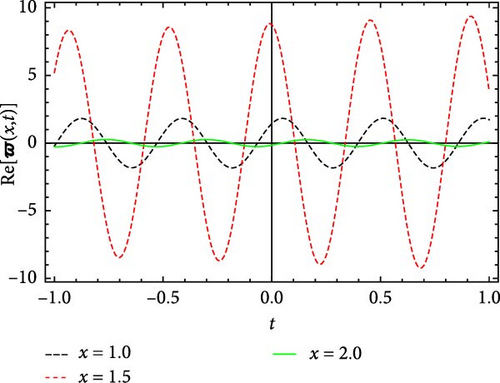
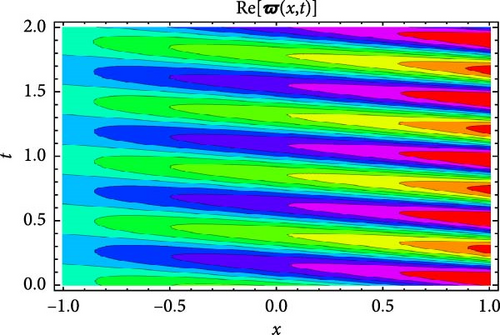
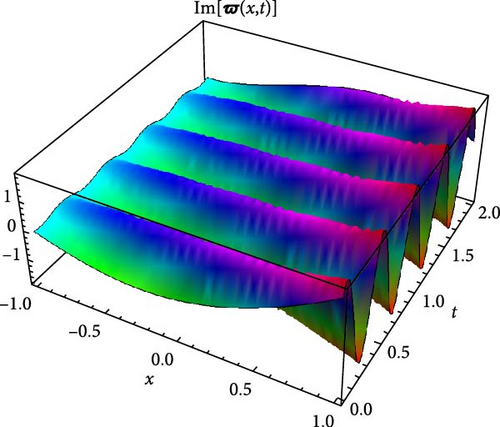
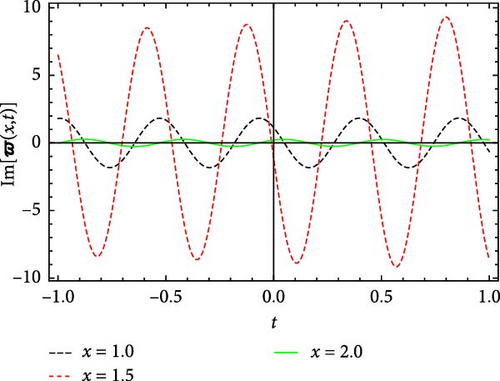
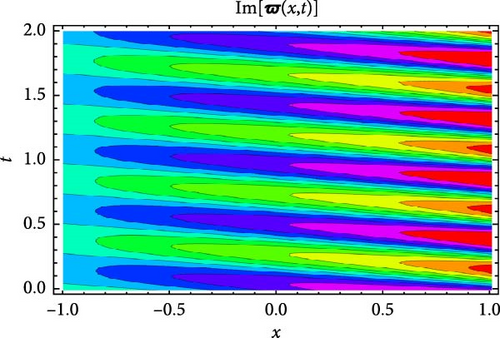
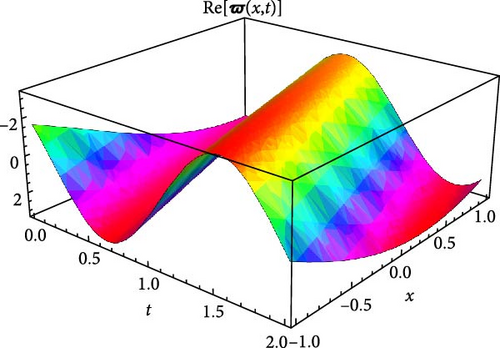
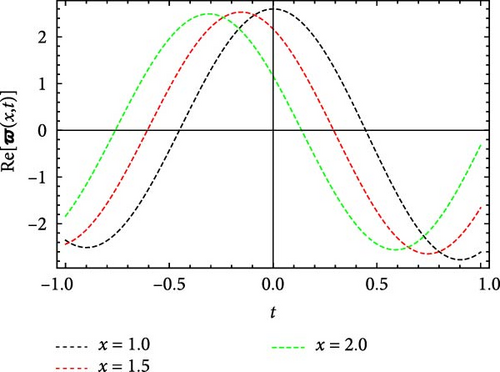
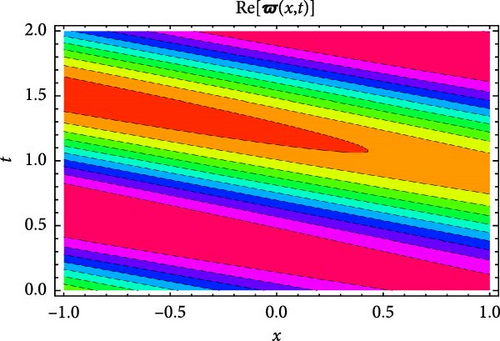
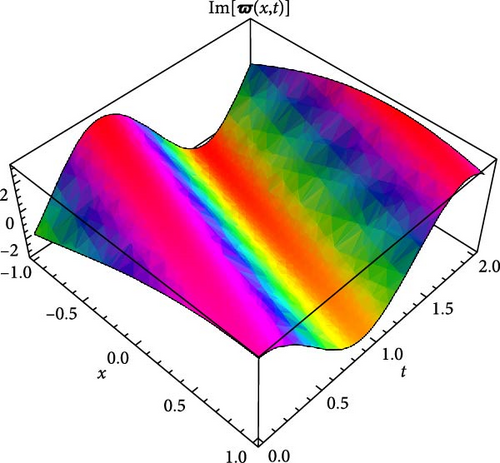
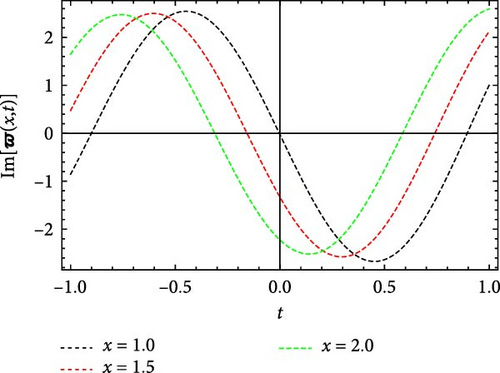
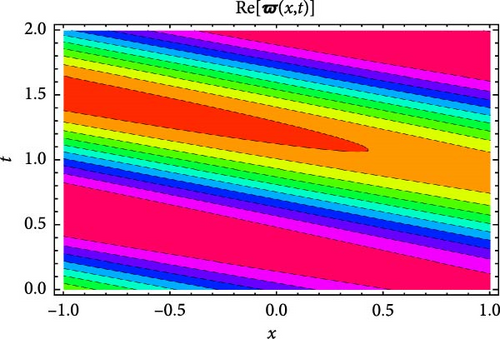
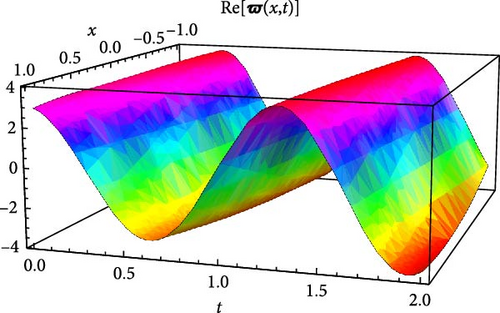
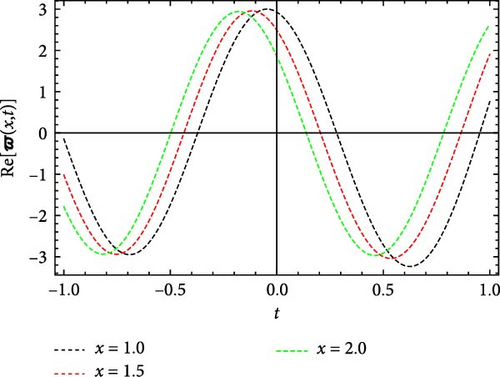
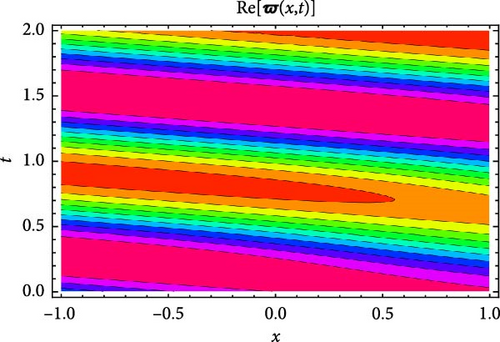
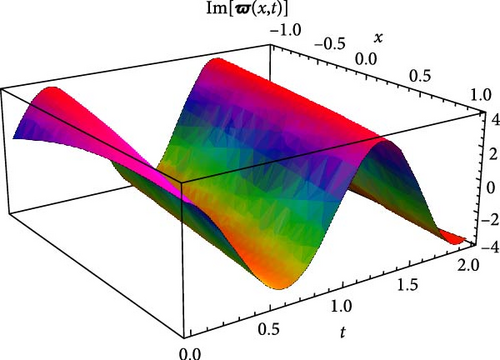
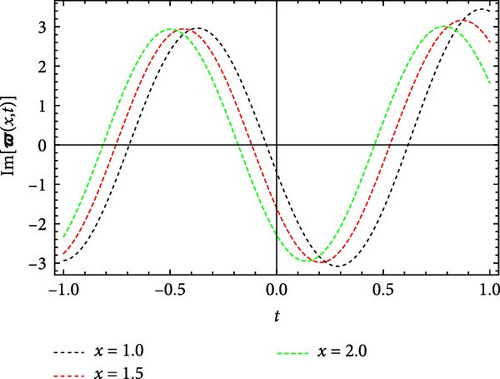

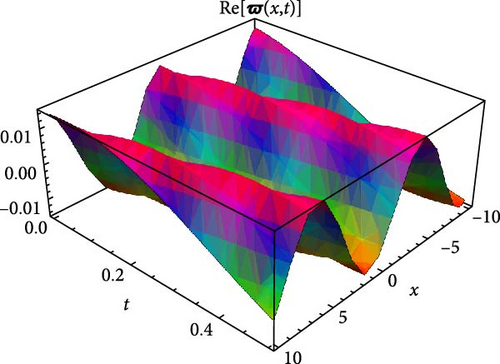
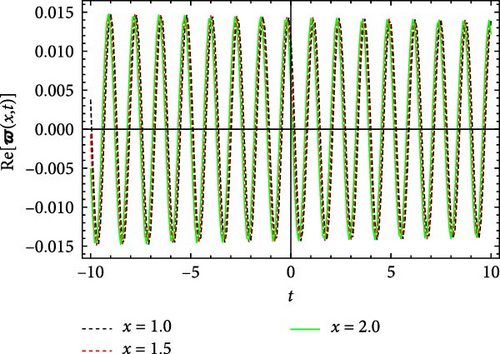
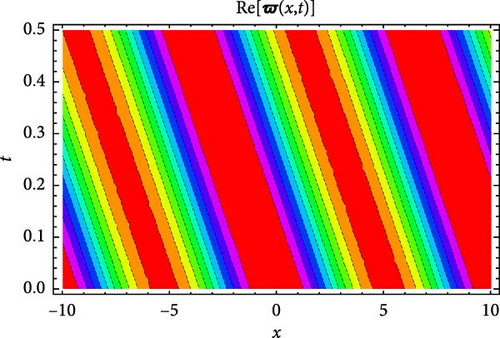
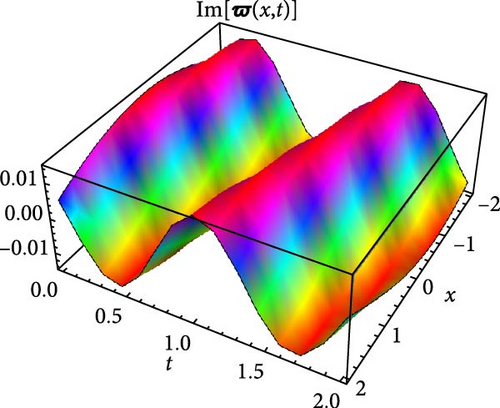
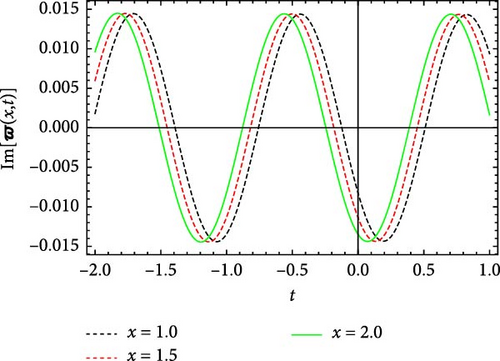

The application of the GERF method and PP close not only shows their utility in getting exact solutions for complex nonlinear equations but also delivers understanding into the design and optimization of devices that leverage these nonlinear chiral interactions, paving the way for creations in photonics and material science. In the Quantum Hall effect, edge states play a crucial role in the transport properties of the system. These edge states are chiral, meaning they move in a single direction along the boundary of the sample. Stable solitons, localized wave packets that keep their shape during propagation, can be employed to model these edge states. Chiral solitons can explain the unidirectional movement of electrons along the edge of a Quantum Hall system. The GERF Method is more straightforward and concentrates on yielding a wide diversity of soliton solutions, involving exponential, hyperbolic, trigonometric, bright, periodic, and dark soliton solutions. It involves directly creating solutions by utilizing exponential functions and is highly effective for visualizing soliton characteristics, such as in 2D, 3D, and contour plots. On the other hand, by utilizing the PP method, we attained a limited set of soliton solutions, primarily focusing on periodic solitons, in contrast to the GEFM, which provides a broader range of soliton solutions, including exponential, hyperbolic, and trigonometric types. Moreover, we compared our results with the existing paper [51], as shown in Table 1.
| Contents | Solutions | Type of soliton |
|---|---|---|
| GERF method | Periodic, bright, and dark | |
| — | ||
| Paul-Painlevé approach | Periodic | |
| — | ||
| — | ||
| Extended fan method [51] | Dark, singular periodic | |
| — | ||
| — | ||
6.1. Sensitivity Analysis
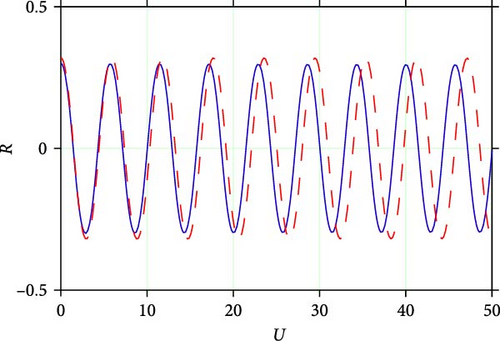
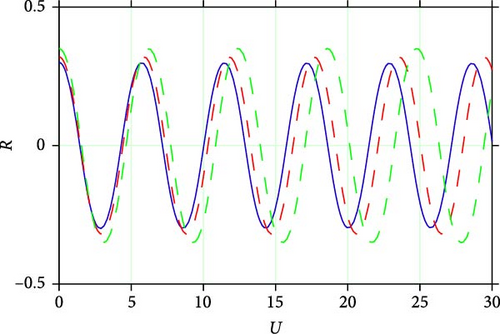
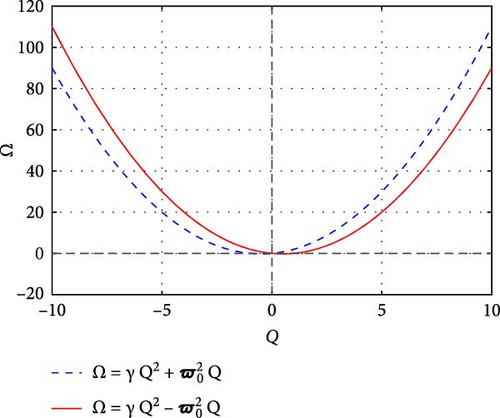
6.2. Modulation Stability
- •
If Im(Ω) > 0, the system is unstable (modulation instability).
- •
If Im(Ω) = 0, the system is stable.
Since Ω is real, there is no modulation instability.
7. Conclusion
This research utilized the GERF method and the PP approach to attain novel and effective optical soliton structure solutions for the CNLSE-BP model. The acquired solutions, including periodic wave solitons, trigonometric and hyperbolic solitons, as well as bright and dark solitons, reveal the impact of these approaches in solving nonlinear wave equations. As, related to previous studies, the results yield new insights into soliton dynamics and contribute to the broader understanding of NLSEs. Furthermore, the study demonstrates the potential applications of the CNLSE-BP model in quantum Hall systems and nonlinear optics, especially in describing the unidirectional propagation of long waves. A detailed sensitivity and modulation stability analysis was executed to explore the behavior of solitons under different parametric conditions, enhancing the comprehension of their stability and modulation characteristics.
Although these significant contributions, there are several promising directions for future research. Expanding the current study to higher-dimensional CNLS models could contribute deeper insights into soliton interactions and wave turbulence in complex physical systems. Exploring the effects of perturbations, nonlocal interactions, and fractional-order derivatives may further refine the stability analysis and reveal new soliton behaviors under more realistic conditions. Additionally, experimental validation of these theoretical results in quantum optics, photonic lattices, and Bose-Einstein condensates would strengthen their practical applicability. Moreover, investigating the role of CNLSE-BP solitons in nonlinear optical applications, such as fiber optics, metamaterials, and optical communication systems, could open new technological possibilities.
Conflicts of Interest
The authors declare no conflicts of interest.
Author Contributions
All authors contributed equally to this article.
Funding
This research is funded by researchers supporting project number (RSPD2025R733), King Saud University, Riyadh, Saudi Arabia.
Acknowledgments
The authors have nothing to report.
Open Research
Data Availability Statement
All data that support the findings of this study are included within the article.




